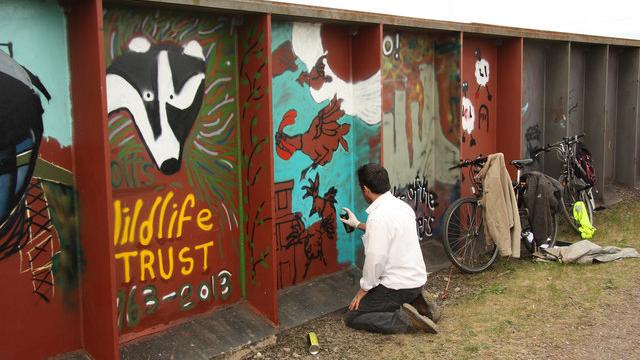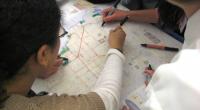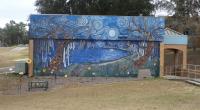
L DFSS Design a Viaduct Mural

Bird, C. J. (2014). Retrieved June 21, 2016 from the Hermosa, Chicago Wiki: https://en.wikipedia.org/wiki/Hermosa,_Chicago
Brief:
The DFSS Design a Viaduct Mural challenge is a local design opportunity which asks participants to think outside the box and imagine a site-specific viaduct mural for a Chicago area neighborhood.
This design challenge is presented by the Chicago Architecture Foundation in partnership with the Department for Family Services 2016 Summer Infrastructure program. Over 600 high school students will spend the summer working alongside construction industry professionals throughout the city of Chicago and join CAF for a one-day hands-on studio workshop and neighborhood tour. The program provides a platform for students to explore how our daily lives can be transformed by the built environment.
Design Challenge
How might a mural transform a community?
Design a public mural for a viaduct that is at least 10 feet tall by 12 feet wide that will beautify and improve the public environment for area residents as a community-based work of art.
Think About:
- Do you live near any murals or viaducts?
- Do murals have a positive or negative impact on communities? Why or why not?
Chicago and Public Art
Chicago's Cultural Plan outlines a vision for art and culture that incorporates public art into projects across the city. Projects include exhibitions, installations and art-making activities in various neighborhoods
Read the press release detailing the Chicago Cultural Plan

What is the Design Process?
Find our more about the Design Process for help getting through this design challenge.

Rutter, C. (2010, March 19). Retrieved June 21, 2016 from Castlefield Wiki: https://en.wikipedia.org/wiki/Castlefield
In the Collect Info step of the design process, try to gather as much information as possible about murals and viaducts, along with the people who will see it. You can't propose solutions until you figure out and document the design problem
About Site-Specific Murals
Site-specific murals are designed and created for a specific location and reflect ideas about the people who live near the site. They often use symbols, vibrant colors or text to tell the story of the local community. Murals under viaducts beautify a typically overlooked space and promote community pride and engagement. The City of Chicago’s goal is to provide citizens with an improved public environment and enhance city spaces with quality works of art. In fall of 2016 the city will produce the first ever Chicago Public Art Plan which will provide a strategy for the planning and preservation of public art pieces across the city. Many of the public art pieces in discussion are large public murals. The designs developed must be engaging, attractive, as well as represent and enhance the unique qualities of the site and local community.
What site will you choose?
Try This:
- Go out in your neighborhood and look for viaducts and murals. Are there any near you? Where are they typically found? Take notes on how many you see, where they are, and what images or colors are used.
- Take photos of murals, viaducts and bridges that you see.
- Interview neighbors about murals they may like or not like in their area. Ask them why they do or don’t like it. What might they have done differently?
Think About:
- How many viaducts are near you? Do they have mural on them?
- What types of imagery are used on the murals? Why do you think they used those images?
- If you were to design a viaduct mural, where would it be? Is there a specific location that could benefit from a mural?
What is a Viaduct?
Chicago has more than 300 bridge and viaduct structures. Typical viaducts in Chicago are long bridge-like structures carrying a road or railroad over a lower road. They are supported by large arches or beams. The lower roads are often used for slower local traffic and pedestrians to cross under a larger, busy road like a highway.
Viaduct Specifications
The typical height of a viaduct is 11 to 14 feet. Head to the City of Chicago's Website for more information about viaduct specificiations in Chicago.

What To Upload?
In the Collect Info step, upload media such as photos, links to videos, even drawings of an existing viaduct. Your uploads should help you understand existing conditions before designing solutions.

Croft, R. (2013, May 4). Retrieved from http://www.geograph.org.uk/photo/3444127
In the Brainstorm Ideas step of the design process, you put some early ideas down on paper that show what you've found in the Collect Info step. You’ve chosen a specific site, so now you should take more photos of the area to show specific new ideas you have.
The simple diagrams you make here will help you understand how the site location and design compare with your new ideas.
Try This
- Find an aerial photo of your site using Google Maps
- Take photos of the wall you plan to use and the surrounding areas.
- Search for other murals online and take notes on what you like about them.
- Upload the images that inspire you here and write about why you like them.
- Draw small individual images and cut them out so you can move them around. Rearrange them to see how you might like to lay out the mural.
- Upload a color palette that you think would best suit the mural.
Think About
- What types of other buildings surround your site? Homes, businesses, parks, parking lots, or an empty field?How will these other buildings and the people who use them impact the design of your mural?
- Think about the neighborhood your mural will be in. What cultures are represented? What are they proud of as a community?
- What would a mural look like in that community? Why?
- What colors and images would you use? Think about what they might symbolize for the people that live there.
Try This
- Start to sketch out parts or the overall design of your mural. What symbols, colors or images will you use? Upload these quick sketches to get feedback. Tell us about the meaning of the symbols and why you would like to use them
Put the different images together to start to compose your mural. Is the layout working? How can you adjust the images to make the layout more appealing? Keep brainstorming and testing new images to help you develop a solution
Mural How-To
The Chicago Public Art Group put together quick tips for designing a mural. Check it out!

What To Upload?
In the Brainstorm / Analyze step, try uploading photos of cool places, spaces, or existing murals that inspire you. You can also upload scans of hand sketches showing your first ideas.

Appalachian Fellows. (2014, June 10). Retrieved from https://www.flickr.com/photos/124513342@N06/14458150161
In the Develop Solutions step, your rough ideas come together with drawings and models that can show others your solutions for a viaduct mural.
Important! Since DiscoverDesign is about investigating the design process, the other people viewing your project - other students around the country, your teacher, and mentors - will see how your ideas have changed over time. This means that while you're working on your digital model, you’ll want to be sure to keep re-saving it with a new file name every few days as you work through the steps.
Draw a sketch with pencil, pen, marker, colored pencils, paint or even digitally to illustrate your ideas. You can upload photos (JPG files) of your drawings here. Show us a few different options to consider.
Think About:
- How did your design change from your initial idea to a possible solution? Were there any sketches in the brainstorm step that changed your initial idea? How so?
- Think about the neighborhood your mural will be in. What cultures are represented? What are they proud of as a community? Does your mural address these ideas accurately? If not, you may need to go back to the brainstorm step!
Bronzeville Murals
Explore community murals in one of Chicago's historic neighborhoods: Bronzeville.

What To Upload?
In the Develop step, your initial ideas from the previous step (Brainstorm / Analyze) should start taking shape. Try uploading images (JPG, GIF) of digital or physical models based off of your initial ideas.

Sputzer, S. (2016, February 28). Retrieved from https://www.flickr.com/photos/10413717@N08/25091233600
The final step of the design process is to create more finished drawings that illustrate your ideas to others. Remember, your explanation text, and the types of drawings, images, and models you share need to tell the whole story of your project to someone who may or may not have ever visited your site or even your city.
Continue to collect feedback from your peers, teachers and the online community to help you improve on your final design. Be sure to review and add constructive comments on the work of other students who are solving the same design problem. If your ideas change, be sure to explain your thinking and let others know about the new work you have posted to your account.
You might want to share sketches, color palettes, detail images and the versions of your composition.
Try This
- Review your design and test it against your original problem statement that you wrote for the Overview. Does it meet this criteria?
- Make a list of your ideas, sketches, and study models. For your final design you will want to write and post a short but effective paragraph of your process and the unique solutions you found developed. Tell us about your ideas.
- Think about the originality of your design, how you’ve creatively solved the design challenge, and how your mural meets the needs of a specific community.

What To Upload?
Try uploading final hand or digital renderings, images of a finished physical model, or the actual mural itself.